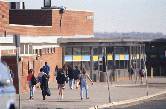
TUESDAY, Dec. 14 (HealthDay News) — By outfitting students and teachers with wireless sensors, researchers simulated how the flu might spread through a typical American high school and found more than three-quarters of a million opportunities for infection daily.
Over the course of a single school day, students, teachers and staff came into close proximity of one another 762,868 times — each a potential occasion to spread illness.
The flu, like the common cold and whooping cough, spreads through tiny droplets that contain the virus, said lead study author Marcel Salathe, an assistant professor of biology at Pennsylvania State University.
The droplets, which can remain airborne for about 10 feet, are spewed when someone infected coughs or sneezes, Salathe said. But it’s not known how close you have to be to an infected person to get the flu, or for how long, although just chatting briefly may be enough to pass the virus.
When researchers ran computer simulations using the “contact network” data collected at the high school, their predictions for how many would fall ill closely matched absentee rates during the actual H1N1 flu pandemic in the fall of 2009.
“We found that it’s in very good agreement,” Salathe said. “This data will allow us to predict the spread of flu with even greater detail than before.”
The study is published in the Dec. 13 online edition of the Proceedings of the National Academy of Sciences.
Figuring out how and where an infectious disease will spread is highly complex, said Daniel Janies, an associate professor of biomedical informatics at Ohio State University in Columbus.
The genomics of the disease, or the genetic makeup of the pathogen, can influence its ability to infect humans as can environmental factors, such as weather and whether a particular virus or bacteria thrives during a given season. Your genetic makeup and health also influence how susceptible you are to a particular pathogen, he said.
Another factor is how and when people interact with one another, which is what this study explores well, Janies said.
“Transmission depends on close contact so that respiratory droplets can go from person to person. In a school, or in an airplane, people are closer than they would be in a normal environment,” Janies said. “Instead of assuming how people interact, they measured it in the real world.”
Typically, computer simulations about the spread of disease rely on lots of assumptions about social interactions, sometimes gleaned through U.S. Census data or traffic statistics, according to background information in the article.
Few researchers have looked specifically at how people interact in a location where there is lots of close contact, such as a school, Salathe said.
“Simply asking people how many people they talked to in a given day doesn’t work,” Salathe said. “You can have hundreds of really short interactions throughout the day and there is no way to recall all of them.”
In the study, 788 students, teachers and staff, which included 94 percent of the school population that day, wore a matchbook-sized wireless sensor on a lanyard around their necks. The device sent out a signal every 20 seconds that could detect if someone in close proximity was also wearing a sensor.
Though there are ethical implications, it’s possible that in cases of vaccination shortage, it might make sense to give vaccination priority to those with large contact networks, Salathe said.
More information
The U.S. Centers for Disease Control and Prevention has more on the transmission of infectious diseases.

